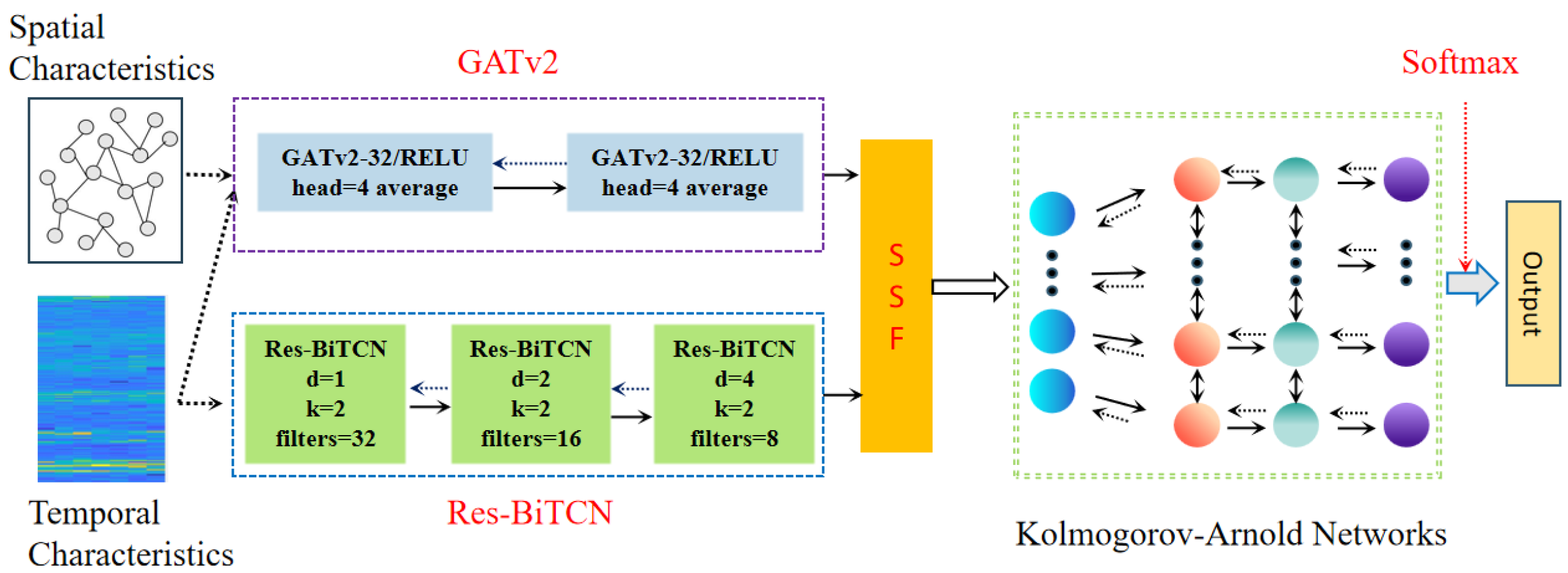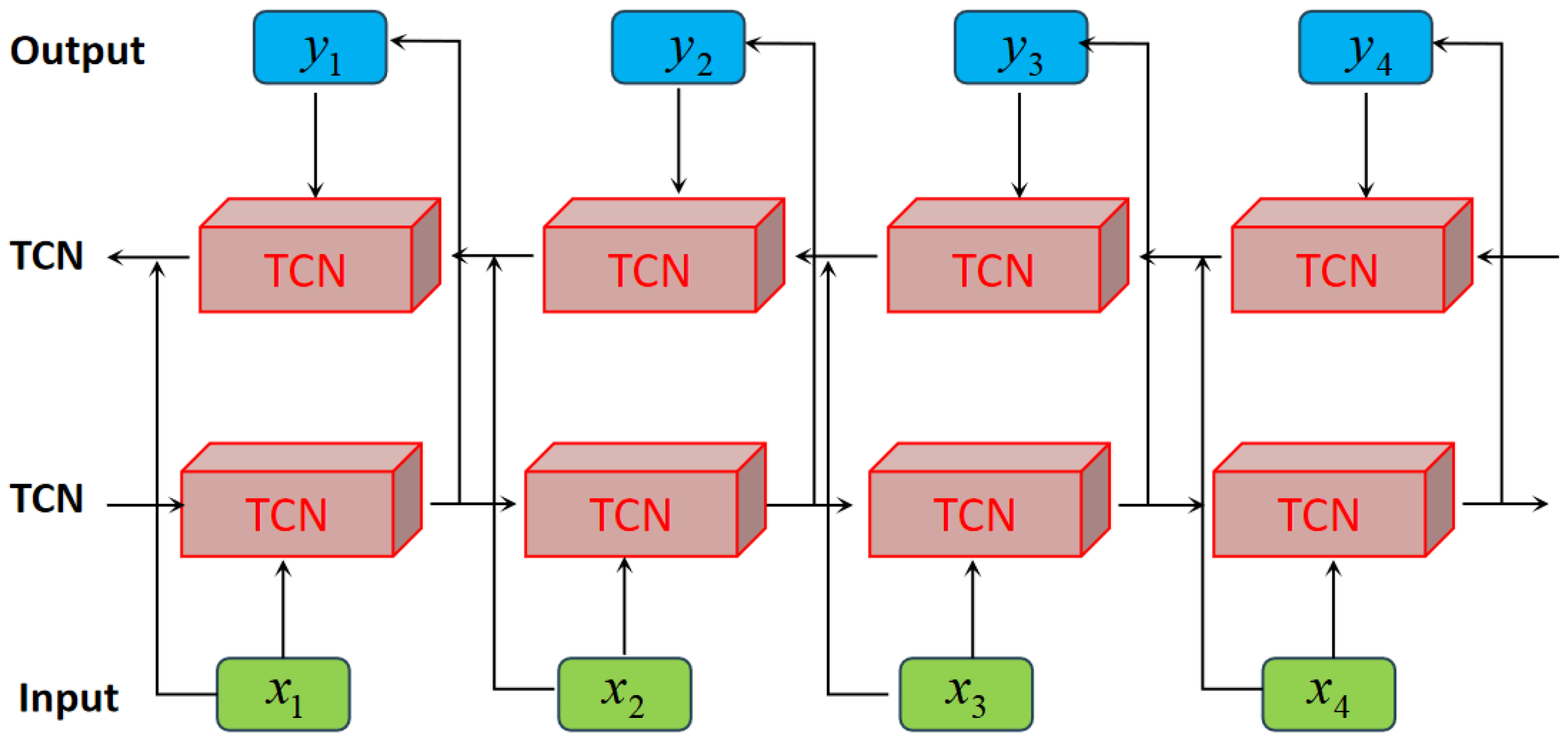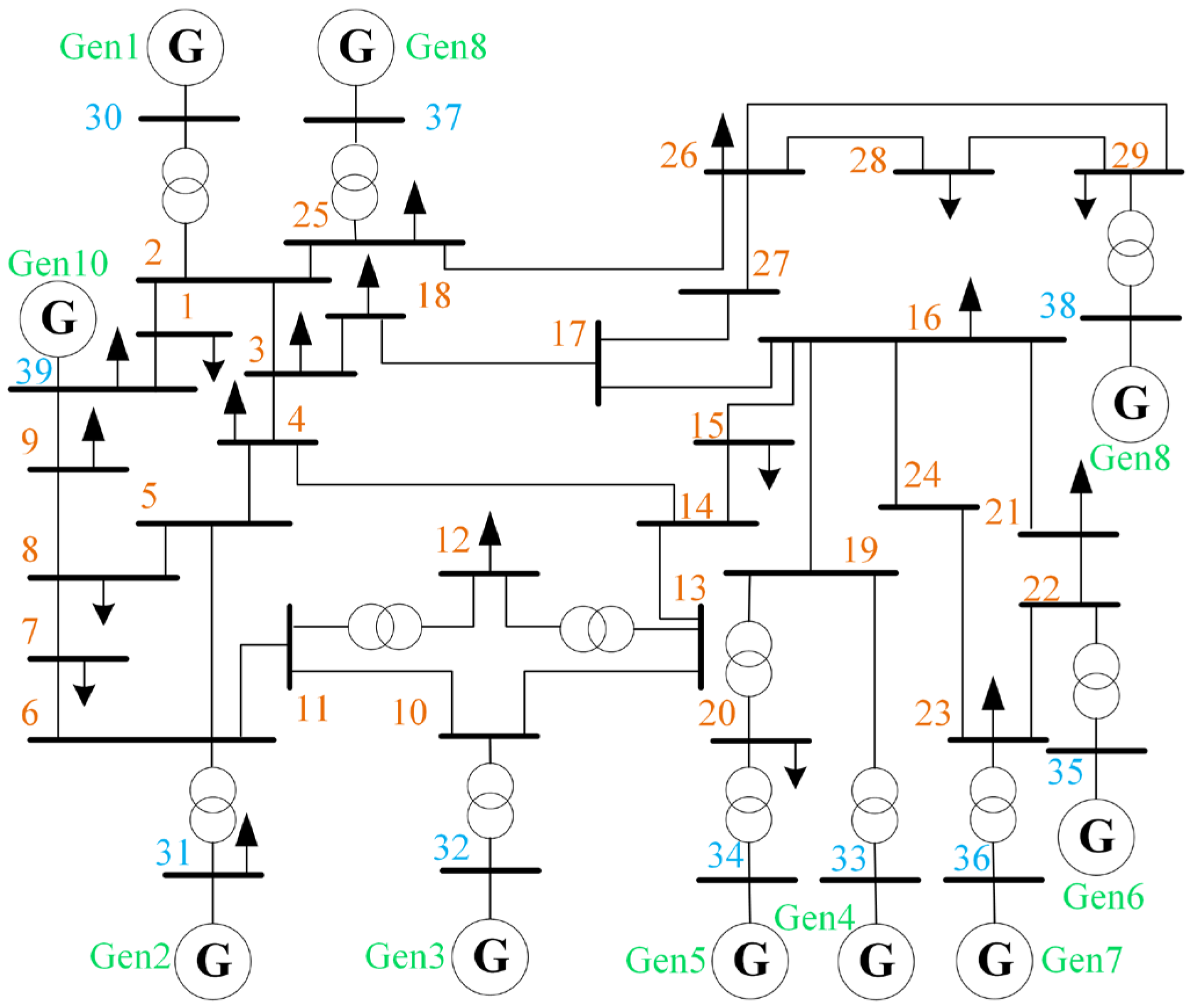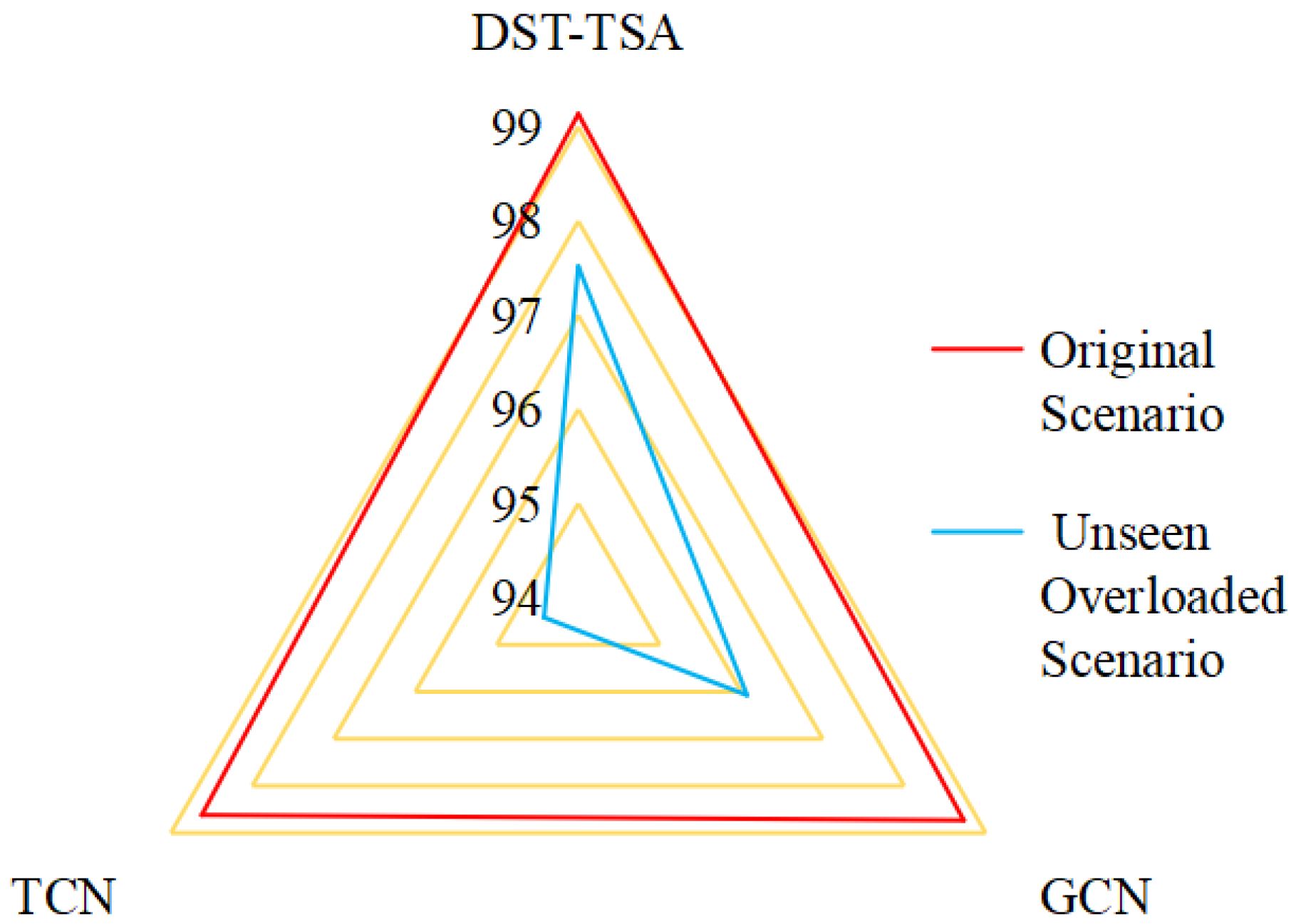Transient Stability Assessment of Power Systems Built upon a Deep Spatio-Temporal Feature Extraction Network
Abstract
1. Introduction
2. Deep Spatio-Temporal Feature Extraction Network
2.1. The Working Mechanism of Improved Graph Attention Network
2.2. The Working Mechanism of Residual Bidirectional Temporal Convolutional Network
2.3. The Spatio-Temporal Feature Fusion Layer
2.4. The Working Mechanism of Kolmogorov–Arnold Network
3. TSA Model Based on DST-TSA
3.1. The Input and Output of the Model
3.2. The Output of Evaluation Model and Stability Criterion
3.3. The Weighted Cross-Entropy Loss Function for Imbalanced Samples
3.4. Evaluation Metrics
4. Case Study Analysis
4.1. The New England 10-Machine 39-Bus System
4.1.1. The Construction of Sample Set
4.1.2. The Comparative Analysis of Model Performance
4.1.3. The Ablation Experiment
4.1.4. Performance Comparison Among GATv2, Res-BiTCN and GAT, BiTCN
4.1.5. Performance Analysis Under Noisy Conditions
4.1.6. Generalization Performance Evaluation Under Unseen Scenarios
4.2. Large-Scale Power Grid Testing
5. Conclusions
Author Contributions
Funding
Data Availability Statement
Conflicts of Interest
References
- Xia, S.; Zhang, C.; Li, Y.; Li, G.; Ma, L.; Zhou, N. GCN-LSTM Based Transient Angle Stability Assessment Method for Future Power Systems Considering Spatial-Temporal Disturbance Response Characteristics. Prot. Control Mod. Power Syst. 2024, 9, 108–121. [Google Scholar] [CrossRef]
- Liu, C.; Li, B.; Zhang, Y.; Jiang, Q.; Liu, T. The LCC Type DC Grids Forming Method and Fault Ride-Through Strategy Based on Fault Current Limiters. Int. J. Electr. Power Energy Syst. 2025, 170, 110843. [Google Scholar] [CrossRef]
- Wu, S.; Zheng, L.; Hu, W.; Yu, R.; Liu, B. Improved Deep Belief Network and Model Interpretation Method for Power System Transient Stability Assessment. J. Mod. Power Syst. Clean Energy 2020, 8, 27–37. [Google Scholar] [CrossRef]
- Zadkhast, P.; Jatskevich, J.; Vaahedi, E. A Multi-Decomposition Approach for Accelerated Time-Domain Simulation of Transient Stability Problems. IEEE Trans. Power Syst. 2015, 30, 2301–2311. [Google Scholar] [CrossRef]
- Vu, T.L.; Turitsyn, K. Lyapunov Functions Family Approach to Transient Stability Assessment. IEEE Trans. Power Syst. 2016, 31, 1269–1277. [Google Scholar] [CrossRef]
- Diao, R.; Vittal, V.; Logic, N. Design of a Real-Time Security Assessment Tool for Situational Awareness Enhancement in Modern Power Systems. IEEE Trans. Power Syst. 2010, 25, 957–965. [Google Scholar] [CrossRef]
- Sun, K.; Likhate, S.; Vittal, V.; Kolluri, V.S.; Mandal, S. An Online Dynamic Security Assessment Scheme Using Phasor Measurements and Decision Trees. IEEE Trans. Power Syst. 2007, 22, 1935–1943. [Google Scholar] [CrossRef]
- Gao, Q.; Rovnyak, S.M. Decision Trees Using Synchronized Phasor Measurements for Wide-Area Response-Based Control. IEEE Trans. Power Syst. 2011, 26, 855–861. [Google Scholar] [CrossRef]
- Dong, L.; Du, H.; Mao, F.; Han, N.; Li, X.; Zhou, G. Very High Resolution Remote Sensing Imagery Classification Using a Fusion of Random Forest and Deep Learning Technique—Subtropical Area for Example. IEEE J. Sel. Topics Appl. Earth Observ. Remote Sens. 2020, 13, 113–128. [Google Scholar] [CrossRef]
- Sotnikov, D.; Lyly, M.; Salmi, T. Prediction of 2G HTS Tape Quench Behavior by Random Forest Model Trained on 2-D FEM Simulations. IEEE Trans. Appl. Supercond. 2023, 33, 6602005. [Google Scholar] [CrossRef]
- Geeganage, J.; Annakkage, U.D.; Weekes, T.; Archer, B.A. Application of Energy-Based Power System Features for Dynamic Security Assessment. IEEE Trans. Power Syst. 2015, 30, 1957–1965. [Google Scholar] [CrossRef]
- Ertekin, S.; Bottou, L.; Giles, C.L. Nonconvex Online Support Vector Machines. IEEE Trans. Pattern Anal. Mach. Intell. 2011, 33, 368–381. [Google Scholar] [CrossRef] [PubMed]
- He, M.; Vittal, V.; Zhang, J. Online Dynamic Security Assessment with Missing PMU Measurements: A Data Mining Approach. IEEE Trans. Power Syst. 2013, 28, 1969–1977. [Google Scholar] [CrossRef]
- Ma, R.; Eftekharnejad, S.; Zhong, C. Predictive Online Transient Stability Assessment for Enhancing Efficiency. IEEE Open Access J. Power Energy 2024, 11, 207–217. [Google Scholar] [CrossRef]
- Liu, W.; Kerekes, T.; Dragicevic, T.; Teodorescu, R. Review of Grid Stability Assessment Based on AI and a New Concept of Converter-Dominated Power System State of Stability Assessment. IEEE J. Emerg. Sel. Topics Ind. Electron. 2023, 4, 928–938. [Google Scholar] [CrossRef]
- Shen, Y.; Wang, Y.; Li, Y.; Wang, Z.; Huang, C.; Blaabjerg, F. Hierarchical Time-Series Assessment and Control for Transient Stability Enhancement in Islanded Microgrids. IEEE Trans. Smart Grid 2023, 14, 3362–3374. [Google Scholar] [CrossRef]
- Badran, Y.; Isbeih, Y.J.; Moursi, M.S.E.; Al Hosani, K.H. A Data Driven Stability Assessment Approach for Multiple Microgrids Interconnection. IEEE Trans. Ind. Appl. 2025, 61, 2646–2661. [Google Scholar] [CrossRef]
- Yan, R.; Geng, G.; Jiang, Q.; Li, Y. Fast Transient Stability Batch Assessment Using Cascaded Convolutional Neural Networks. IEEE Trans. Power Syst. 2019, 34, 2802–2813. [Google Scholar] [CrossRef]
- Shi, Z.; Yao, W.; Zeng, L.; Wen, J.; Fang, J.; Ai, X.; Wen, J. Convolutional Neural Network-Based Power System Transient Stability Assessment and Instability Mode Prediction. Appl. Energy 2020, 263, 114856. [Google Scholar] [CrossRef]
- Yu, J.J.Q.; Hill, D.J.; Lam, A.Y.S.; Gu, J.; Li, V.O.K. Intelligent Time-Adaptive Transient Stability Assessment System. IEEE Trans. Power Syst. 2018, 33, 1049–1058. [Google Scholar] [CrossRef]
- Shao, Z.; Wang, Q.; Cao, Y.; Cai, D.; You, Y.; Lu, R. A Novel Data-Driven LSTM-SAF Model for Power Systems Transient Stability Assessment. IEEE Trans. Ind. Informat. 2024, 20, 9083–9097. [Google Scholar] [CrossRef]
- Li, B.; Wu, J. Adaptive Assessment of Power System Transient Stability Based on Active Transfer Learning with Deep Belief Network. IEEE Trans. Autom. Sci. Eng. 2023, 20, 1047–1058. [Google Scholar] [CrossRef]
- Tan, B.; Yang, J.; Tang, Y.; Jiang, S.; Xie, P.; Yuan, W. A Deep Imbalanced Learning Framework for Transient Stability Assessment of Power System. IEEE Access 2019, 7, 81759–81769. [Google Scholar] [CrossRef]
- Umbereen, S.; Weiss, X.; Rolander, A.; Ghandhari, M.; Eriksson, R. Investigating the Performance of MLE and CNN for Transient Stability Assessment in Power Systems. IEEE Access 2024, 12, 125095–125107. [Google Scholar] [CrossRef]
- Lee, G.; Park, C.; Kim, D.-I. Event Detection-Free Framework for Transient Stability Prediction via Parallel CNN-LSTMs. IEEE Trans. Instrum. Meas. 2024, 73, 9004410. [Google Scholar] [CrossRef]
- Huang, J.; Guan, L.; Su, Y.; Yao, H.; Guo, M.; Zhong, Z. A Topology Adaptive High-Speed Transient Stability Assessment Scheme Based on Multi-Graph Attention Network with Residual Structure. Int. J. Electr. Power Energy Syst. 2021, 130, 106948. [Google Scholar] [CrossRef]
- Shao, C.; He, X.; Ma, L.; Wang, H.; Zhou, C.; Dong, H. Transient Assessment of Power Systems Based on Graph Attention Networks. In Proceedings of the 2024 IEEE 5th International Conference on Advanced Electrical and Energy Systems (AEES), Lanzhou, China, 29 November–1 December 2024; pp. 525–530. [Google Scholar]
- Massaoudi, M.; Zamzam, T.; Eddin, M.E.; Ghrayeb, A.; Abu-Rub, H.; Refaat, S.S. Fast Transient Stability Assessment of Power Systems Using Optimized Temporal Convolutional Networks. IEEE Open J. Ind. Appl. 2024, 5, 267–282. [Google Scholar] [CrossRef]
- Taj, T.A.; Hasanien, H.M.; Alolah, A.I.; Muyeen, S.M. Transient Stability Enhancement of a Grid-Connected Wind Farm Using an Adaptive Neuro-Fuzzy Controlled-Flywheel Energy Storage System. IET Renew. Power Gener. 2015, 9, 792–800. [Google Scholar] [CrossRef]








| Actual System State | Prediction Result | |
|---|---|---|
| Stable | Unstable | |
| Stable | ||
| Unstable | ||
| Set | |
|---|---|
| Test system | The IEEE 39-Bus System |
| Total buses | 39 |
| Total transmission lines | 46 |
| Fault line | All the transmission lines |
| Fault duration | 0.02 s, 0.04 s, ..., 0.34 s, 0.36 s |
| Fault locations | 3%, 6%, ..., 99% |
| Fault type | Three-phase short-circuit faults |
| Total samples | 13,600 |
| Total stable samples | 8457 |
| Total unstable samples | 5143 |
| Model | /% | /% | /% | /% |
|---|---|---|---|---|
| DST-TSA | 99.14 | 99.46 | 98.65 | 99.28 |
| GCN | 98.73 | 99.26 | 98.31 | 98.79 |
| TCN | 98.62 | 98.38 | 98.65 | 98.52 |
| LSTM | 98.57 | 98.91 | 97.84 | 98.37 |
| CNN | 98.22 | 97.85 | 98.38 | 98.11 |
| RF | 95.75 | 96.93 | 93.80 | 95.34 |
| SVM | 94.83 | 94.09 | 95.33 | 94.71 |
| Model | /% | /% | /% | /% |
|---|---|---|---|---|
| Ablation Model 1 | 98.91 | 99.72 | 98.01 | 98.77 |
| Ablation Model 2 | 98.75 | 98.39 | 98.90 | 98.65 |
| Model | /% | /% | /% | /% |
|---|---|---|---|---|
| DST-TSA | 98.88 | 98.66 | 98.92 | 98.78 |
| GCN | 98.51 | 98.12 | 98.65 | 98.39 |
| TCN | 98.36 | 97.86 | 98.64 | 98.25 |
Disclaimer/Publisher’s Note: The statements, opinions and data contained in all publications are solely those of the individual author(s) and contributor(s) and not of MDPI and/or the editor(s). MDPI and/or the editor(s) disclaim responsibility for any injury to people or property resulting from any ideas, methods, instructions or products referred to in the content. |
© 2025 by the authors. Licensee MDPI, Basel, Switzerland. This article is an open access article distributed under the terms and conditions of the Creative Commons Attribution (CC BY) license (https://creativecommons.org/licenses/by/4.0/).
Share and Cite
Nan, Y.; Tong, M.; Kong, Z.; Zhao, H.; Zhao, Y. Transient Stability Assessment of Power Systems Built upon a Deep Spatio-Temporal Feature Extraction Network. Energies 2025, 18, 4547. https://doi.org/10.3390/en18174547
Nan Y, Tong M, Kong Z, Zhao H, Zhao Y. Transient Stability Assessment of Power Systems Built upon a Deep Spatio-Temporal Feature Extraction Network. Energies. 2025; 18(17):4547. https://doi.org/10.3390/en18174547
Chicago/Turabian StyleNan, Yu, Meng Tong, Zhenzhen Kong, Huichao Zhao, and Yadong Zhao. 2025. "Transient Stability Assessment of Power Systems Built upon a Deep Spatio-Temporal Feature Extraction Network" Energies 18, no. 17: 4547. https://doi.org/10.3390/en18174547
APA StyleNan, Y., Tong, M., Kong, Z., Zhao, H., & Zhao, Y. (2025). Transient Stability Assessment of Power Systems Built upon a Deep Spatio-Temporal Feature Extraction Network. Energies, 18(17), 4547. https://doi.org/10.3390/en18174547




